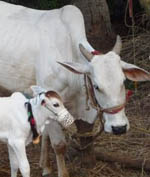 |
|
 |
|
 All mammals at the time of parturition secrete collostrum from their nipples. All mammals at the time of parturition secrete collostrum from their nipples.
It is a thin yellowish milky fluid rich in antibodies and consists largely of serum
and white blood cells. It precedes the production of true milk and is just
sufficient for and meant exclusively for the just delivered baby. High in energy, protein, vitamins (especially A D E and B12), minerals and most importantly containing high levels of imunoglobulins, by suckling the collostrum, passive immunity is transferred from the mother to the newborn thus enabling it to fight off infections during its life time.
Called bovine colostrum, beestings or foremilk, this super-nutritious liquid is secreted for the first day or two by the cow or buffalo after she has calved. Although it is a vital food for newborn calves, it is taken away by humans and usually consumed as a steamed pudding. Commonly known as khees in India, colostrum is also called gau-piyush and cheek in Hindi, junnu in Telegu, seem paal in Tamil, geena in Konkani, kharwas in Marathi, bari in Gujarati, and palethi
in Punjabi.
Beauty Without Cruelty classifies colostrum as non-vegetarian: a product derived upon depravation and cruelty to calves, it positively needs to be shunned – whether as khees or processed into capsules/powder and marketed as a supplement. Bovine colostrum is meant to build immunity in calves, not humans.
|
Stolen Milk
|
The ultimate cruelty in the dairy industry now set to be perpetrated in a big way in India too, is to feed calves with milk replacer and take away the milk from cows and she-buffaloes for human consumption. Common ingredients in commercial milk replacers include a combination of ingredients such as whey, protein concentrate (from whey, soy, wheat, potato, whereas the most recent abroad consists of red blood cell, plasma and fish proteins), animal and vegetable fat, vitamins, minerals and amino acids. Ingredients such as skim milk, butter milk and whole milk are not usually included in the formulation due to their cost and if they are used they are less than 1%. A programme launched under the Maharashtra State Animal Husbandry and Dairy Commission Committee in October 2005 by the Kolhapur Zilla Sahakari Dudh Utpadak Sangh Ltd (known for its Gokul brand milk) for enhancing milk productivity promotes its patented milk replacer and calf starter for calves thereby reducing their rearing expenditure by a third. The milk replacer that contains protein 25% & fat 7% reduces the first three months feeding expenses of the calf. The calf starter contains protein 23% & fat 4% and stimulates the ruminal activity in calves. (Mothers’ milk not allowed to be drunk by calf is sold to humans.)
In short, it is downright unethical to steal the milk meant for the calves, unnatural to feed animal products to them and increase their weight at the rate of up to 700 grams per day.
|
Calf Care?
|
In 2012 the Dairy Development Board of Punjab began aggressively promoting a milk powder substitute obtained from Holland for “better growth of calves”. They recommend that calves should be switched over to this formula milk substitute after 5 days of consuming their mother’s milk.
Furthermore, Punjab’s dairy farmers want to rent out sheds where calves can be taken care of because they admit that their dairies are congested and calves are neglected. A project to implement this idea was submitted by the Ludhiana Dairy Association to the Dairy Development Board.
It is an economic strategy focusing on female calves: a cow costs Rs 60,000 whereas it costs about Rs 75,000 to rear a calf, but if the milk substitute is given it will cost less to rear the calf; and the milk that the calf does not consume can be sold to humans.
Sad, there’s no mention of unwanted male calves.
Sadder still, is this true story: a she buffalo, separated from her calf, became hysterical and throughout the night continuously banged her head against the tree truck to which she was tied with a short chain. When released the next morning, she ran towards her calf, slipped and died. The owner mourned the loss of a “cash buffalo” – not the loss of a life – and even called the animal mad.
|
|
| Page last updated on 16/01/15 |
|
|
 |
|
 |
|
|